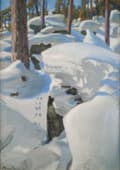
David Johannes NIEMELÄ
Winter Landscape, 1919
Oil on canvas
91 x 66 cm
Signed and dated lower left: D. J. NIEMELÄ | 1919
SOLD
David Johannes NIEMELÄ
(Finland, 1874 - ? )
A Finnish painter born in 1874, little is known about David Johannes Niemelä. His birth name was Nivuniemi, but we do not know why he decided to change his surname. In his paintings his favourite subjects were snowy landscapes and sunny summer skies, sceneries familiar to him from the Finnish rural countryside.
In May 1915, Niemelä organized an art exhibition jointly with his compatriot painter Berndt Frang-Ponsio in the Näsilinna, a neo-Baroque mansion in Tampere, capital of the province of Pirkanmaa. Not surprisingly, this artist exhibited winter-themed landscapes and paintings of birds.
In 1923, he held a group exhibition in Vyborg with the painters Pekka Halonen, Akseli Gallen-Kallela and the sculptor Mikko Hov, all three highly successful, well-known artists.
Pekka Halonen, for example, spent most of his life in France studying with Paul Gauguin. Akseli Gallen-Kallela exhibited with Edvard Munch in an exhibition in Berlin in 1895, played a leading role in the Finnish pavilion at the Universal Exhibition in Paris in 1900, and exhibited at the Venice Biennale in 1914. His work is considered the link between Finnish Symbolism and Expressionism.
This data can be useful to let us understand that, although David Johannes Niemelä still remains fairly unknown to the general public, his art has always stood out for its quality and refinement. It was probably the work of Akseli Gallen-Kallela that inspired him (Fig. 1), leading him to become a decidedly talented artist worthy of becoming known. His use of light, the photographic approach to the compositions, even the compactness of the snowdrifts, were characteristic elements of Gallen-Kallela's works, which Niemelä looked at and reworked according to his own sensibility.

Fig. 1 - Akseli Gallen-Kallela (1865-1931), La Tana della Lince (The Lynx's Lair), 1906
In the painting presented here, the northern light illuminates from the left the copious accumulation of snow of a winter landscape. Amid the green fir trees and the trunks of the characteristic birches we glimpse the blue Finnish sky. The same blue that the artist used to render shadows and reflections on the white snow. Although the element of light that invades the work and warms the winter painting is present, its heat is not enough to melt the cascade of ice descending from above, helping to give the painting an interesting vertical momentum. A work which commemorates the beauty and charm of the Nordic lands.
Join the mailing list
Subscribe to our newsletter to receive all the news about exhibitions, fairs and new acquisitions!